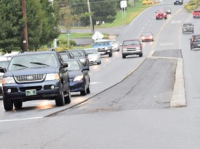Struggle to afford heating costs hits new high
 It looked like any wood yard, piles of tree trunks in various stages of processing: long logs still bearing their bark, shorter stacks cut into rounds and neatly split triangles of firewood ready to be shoveled into a piping stove.
It looked like any wood yard, piles of tree trunks in various stages of processing: long logs still bearing their bark, shorter stacks cut into rounds and neatly split triangles of firewood ready to be shoveled into a piping stove.
But to Richard Reeves, the woodlot at an abandoned factory site in Waynesville, is ground zero in the battle to fight winter’s impending cold.
Reeves, a retired school principal, coordinates a firewood program for the needy in Haywood County through Long’s Chapel United Methodist Church to help those unable to heat their own homes.
“If you could see some of the houses…,” Reeves said. “There are a lot of hurting people in Haywood County who can’t afford fuel oil.”
Last month, the seven-year-old Long’s Chapel program delivered its 1,400th truckload of firewood. Reeves expects to hit the 1,500-mark in February. But, it may not be enough.
While nonprofit organizations and charitable programs like this one are scrambling to raise money to help the poor pay for heat — from heating oil deliveries to stopgap measures like space heaters — the past three years has seen a growing breach. Government heating assistance resources have rapidly declined while the number of people needing help has risen.
Related Items
The chasm has left many disabled, poor and elderly mountain residents worried at the prospect of plummeting winter temperatures without the means to raise the thermostat inside.
Charities are upping their appeal to the community to pitch in and help, including the Share the Warmth campaign led by Mountain Projects, a social aid nonprofit based in Haywood and Jackson counties.
“Without them, I don’t know what we would’ve done,” said 72-year-old Melba Garland. Garland, who lives in Canton, received 100 gallons of heating oil last month thanks to Mountain Projects — a delivery that cost more than $400.
Previously, Garland and her son, who makes minimum wage, were using his small paycheck and her social security payment to buy a five-gallon can of oil every few days to heat their small house. Each purchase was just a Band-Aid.
“That lasted two days, then we had to go again,” Garland said.
Garland also has diabetes and suffered a stroke in 2006 — her husband suffered one in the 1990s and now lives in a nearby nursing home. Her medical conditions only complicate the potential consequences of an improperly heated home.
However, she can only guess as to how long the 100 gallons of oil will last her.
“I don’t really know, but I’m going to stretch it out,” Garland said. “We try to keep it cut down as low as we can to save what we got.”
No more money
Monday marked the first day local agencies and county social service departments began accepting applications for the federal low-income heating assistance funds — one of two primary funding streams available from the government to assist with heating needs in the winter.
That funding is far lower than it’s been in years’ past, however.
In the past two years, the amount of public funding available to North Carolina residents for heating, as well as emergency cooling assistance has dropped from $116 million to $47 million. The funding originates from the federal level, is dispersed to the states, and then to local governments.
And each county is feeling the effects.
Haywood County’s allocation dropped from about $1 million to roughly $350,000.
“It was a very significant cut,” said Haywood County Social Services Director Ira Dove. “We’re hoping that folks can still get the services they need.”
Although funding for fuel assistance saw a spike in 2011, and critics say pre-2011 funding was more in-line with current levels. The cost of heating fuel sources has risen, and many residents are still struggling to find their feet in a lagging economy.
Haywood’s Social Services Department has already used about half of its federal money, after receiving it in July.
In addition to aiding low-income residents with heating costs, a portion of the assistance funds are specifically designated for crisis situations — providing temporary relief to people who fall victim to a heating or cooling related emergency, such as a broken furnace or air conditioner or a utility cutoff notice.
Some residents request the emergency funding following a medical ailment that makes the cold, or extreme heat, life threatening. Or, some have young children in the house with breathing conditions aggravated by temperatures above or below a certain threshold.
Dove said despite rationing efforts to conserve the pot of emergency assistance funds — because of the cooler nature of the mountain climate, the early cold spell that brought snow before Halloween in WNC still managed to gobble up those funds by November, well before the dead of winter.
And the story is the same in other mountain counties. Last week, Macon County, which contracts with CareNet to administer emergency heating assistance funds, had only $13,000 left, and Jackson County was already in the same boat as Haywood.
“We’re already out,” said Randal Moss, an income maintenance supervisor with Jackson County’s Social Services Department.
Meaning caseworkers had to refer people in need to nonprofits and other charities for help until the next funding stream — namely heating assistance money for low-income residents — became available Dec. 1. And that’s if the person would even qualify.
Low-income heating assistance is available to the elderly and disabled below a certain income, far below what many consider a living wage. A person making more than $1,200 per month isn’t eligible, yet just 100 gallons of fuel can cost $400 to $500 — almost half a month’s salary.
The low-income heating assistance funds are administered on a first-come first-serve basis. Last year, Jackson County ran out of funding by the end of the first month it started taking applications.
This year, the county has about $56,000 in low-income heating assistance funds to give out — roughly $15,000 less than last year.
Moss estimated qualified households receive an average of $250 from the program, paid directly to the heating oil, propane or electric company. A $15,000 cut could mean 60 households in Jackson County will not receive the help this winter.
Occasionally, local agencies receive contingency funds in January — a late influx of surplus money — but this year, Moss is not holding his breath, neither for those funds nor any substantial boosts to the funding stream in the near future.
“I don’t know, but if you look at the trend from this year and last year, we’ve seen decreases,” Moss said. “It’s a possibility while we get through these economic times, we may continue to see cuts.”
Last winter was the first time in a while that no additional funds came through mid-winter, according to Dean Simpson, chief of Economic and Family Services at the N.C. Division of Social Services.
This year is a big question mark, and Simpson won’t know until January.
Those extra funds can be a lifeline for mountain counties, which don’t garner any additional benefits from the state based on their cold climate and tend to spend their heating assistance funding quickly if the weather is cold.
After an initial cold surge this fall, daytime temperatures have been relatively warm but still drop down at night. If they stop bouncing back, or fall further, there could be a rush of people looking for help.
Simpson encouraged residents who can’t grab government-heating aid to look elsewhere.
“They should look at other community resources also,” she said.
Tackling a shortage
Nonprofits and charities are already bracing for a possible influx of residents seeking help. But the directors of those groups worry about what will happen when the government resources dry up and their organizations are the only outlets left for elevated numbers of needy residents.
Rusty Wallace, assistant director of Haywood Christian Ministry, said his organization had to tighten restrictions on monthly payouts and tighten qualifications for who can receive heating assistance after the cold winter two years ago drained the organization of its resources too early in the season.
“We are also mindful that other programs will be running out of money, or have already run out of money because of federal cutbacks,” Wallace said. “The last thing we want to happen is to have a brutal winter and be out of funds.”
The charity limits its assistance to low-income households that have someone above the age of 70, under the age of 5, or with a serious health condition.
Many receiving the aid are living on fixed incomes, such as a social security or disability check and food stamps, and there is little chance their situation will improve, Wallace said. Others are unemployed, single mothers with several small children and a poorly insulated trailer.
“There’s very little we can do to help their situation,” Wallace said. “They’re the ones who are going to keep coming back to us.”
In 2011, the ministry provided heating oil, propane or kerosene to more than 250 households. In 2010, a more frigid winter, the program helped heat nearly 300 households.
Wallace said the ministry would like to expand the program to help more people in need, but they don’t have any more money to offer.
“We hate to see people go without,” Wallace said. “It’d be nice if we could open up our heating oil program to a wider swath of people, but the fact is we don’t want to run out of money. We don’t want to have a situation where it’s desperate.”
Patsy Dowling, director of the nonprofit Mountain Projects, said she has seen those desperate situations. Her organization partners with Haywood County Social Services to help administer government aid in addition to raising funds of its own to provide heating assistance.
She characterized this year as the lowest point in four years for public heating assistance. And she dreads the possibility of turning people away if funding can’t meet the need.
“When you tell a person who just had chemotherapy there’s no funding and they have to go home and be cold, it’s one of the most heart-wrenching things you can do,” Dowling said. “And I’ve had to do that.”
Furthermore, she explained that cuts to heating assistance might seem to help a government’s bottom line, but carry a swath of hidden costs. An improperly heated home can cause problems for children and make it difficult for them to go home and study.
Cold temperatures can also put stress on people’s bodies and cause them to become ill.
In some of the most serious cases, people who don’t have proper heat will resort to hazardous substitutes with the potential to start fires or fill a residence with toxic gas.
She said one family she worked with had pulled a gas grill inside the house for heat. Another woman in a wheelchair resorted to turning on her oven and leaving it open for warmth.
“It can be a matter of life and death,” Dowling said.
And with funding on the ropes, even the charitable organizations have to stretch a dime to help as many in need as they can. Some organizations have found that certain types of space heaters help in emergency situations to heat one room when it’s not feasible or too expensive to heat an entire house.
The Haywood chapter of Disabled American Veterans recently bought five ceramic space heaters to give out. Previously, the organization helped fill heating fuel tanks, but found that in light of rising fuel prices, a space heater might be a more effective solution.
“Now that the heating oil is so high we found our money will go further with the space heaters,” said Charles Warren, the junior vice commander of Disabled American Veterans. “But, every situation is different.”
The organization advises veterans in need to go through the local Social Services Department first to exhaust all other forms of assistance, but when that’s inadequate, they’ll pitch in.
The local chapter provides many services to a number of disabled veterans, heat is just one of them. The chapter helps as many as 20 or so veterans per year with heating needs, stretching its already strained resources.
And such is the guessing game that every organization providing heating assistance has to grapple with. Both of those numbers — the available funding and number in need — fluctuate with each year.
“You know it all depends on the weather,” Warren said.









